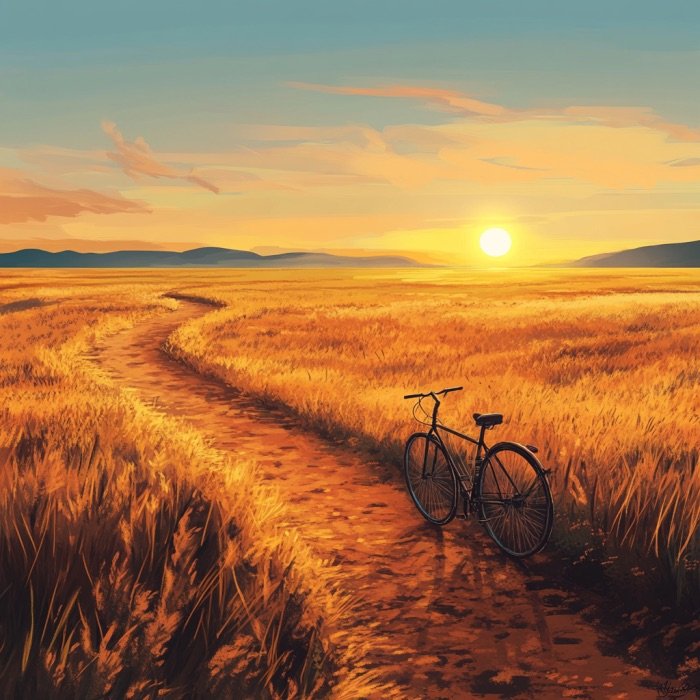How to Cycle
I can still picture my first bike.
It was red, with black handles and training wheels that made a distinct clatter against the pavement. I was six, and the idea of riding without those training wheels felt as impossible as flying.
My dad was crouched beside me, steadying the seat. His hand felt solid, reassuring, like an anchor I wasn’t ready to lose. When he finally let go, I remember the magic of those first few seconds. The wind tickled my face; the world seemed to blur. But then I fell, and everything came crashing back to earth—literally. My knees scraped against the gravel, stinging with fresh cuts, and I burst into tears. It wasn’t just the fall that hurt. It was the heartbreak of how quickly the magic disappeared.
Still, I got back on the bike. Not because I was brave, but because my dad encouraged me to be curious. What if the next ride lasted longer? What if I could feel that way again? The questions were enough to overcome the fear of falling.
There’s a rhythm to cycling, a flow that mirrors life itself.
Pedal, coast, pedal, coast. Every push forward is deliberate, fueled by effort and determination. And then there’s the coasting, those fleeting moments when everything feels effortless, as though the world is carrying me forward. That’s how hope works. It’s fragile, fleeting, and sometimes illogical, but it’s the spark that keeps me moving forward, even after a setback.
Hope is the fuel for life’s journey.
Sometimes it’s the dream of something better, something brighter, something new. Other times, it’s the hope of avoiding something worse. But hope isn’t tied to reality—it’s tied to possibility. And because of that, it’s powerful. It’s also vulnerable.
The most fragile hopes, the ones closest to my heart, often stay unspoken. I hold them quietly, protectively, because saying them out loud feels scary. I might lose them.
I’ve learned the hard way that hope often turns into attachment. There was a project I was leading years ago, one that my team and I poured months of effort into. I wasn’t just working on it—I was building a story in my mind about how it would turn out. I could see the recognition we’d receive, the pride we’d feel, the validation I was chasing.
That story became so real to me, so vivid, that it felt like a certainty. But when reality unfolded, it didn’t match the story I had crafted in my mind. The disappointment was overwhelming. It wasn’t just the failure of the project—it was the collapse of the story I had clung to so tightly.
That’s the thing about attachment. It’s not physical; it’s emotional. It’s the tethering of my identity, my worth, to an outcome that only exists in my mind. And when reality doesn’t align with that outcome—as it so often doesn’t—the disappointment can feel crushing. Reality, in its quiet, indifferent way, just is. It doesn’t apologize for being what it is, and it doesn’t try to align with the fantasies I create.
But disappointment isn’t the end of the cycle. Sitting with it is painful, but also illuminating. I’ve found that when I take the time to reflect on my disappointment, I can begin to see what was at its core. What was I really hoping for? Recognition? Security? A sense of accomplishment? When I understand the “why” behind my disappointment, it starts to lose its grip. And once it loosens, hope begins to creep back in. Slowly, quietly, I find myself pedaling forward again.
Curiosity has been my greatest ally in breaking the cycle of hope, attachment, and disappointment. It reminds me that life is rarely about a single outcome. Instead of anchoring myself to one possibility, I try to stay open to the range of what might unfold. I think back to that first bike ride—falling wasn’t the end. It was part of the process. And each time I got back on, I discovered something new, even if it wasn’t what I wanted.
Reality will always have the final say, and it rarely matches the stories I tell myself. But that doesn’t make the journey any less valuable. Life isn’t about the destination. It’s about the rhythm, the movement, the small victories of simply continuing. Even when I fall, even when the magic doesn’t last, I can get back on the bike of life. And maybe that’s enough.
And that’s how I learned to cycle.




